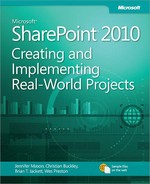The solution in this chapter was built using the features available within SharePoint Enterprise. In the remainder of this section, the different options available with the various other SharePoint licenses will be highlighted.
If you are using SharePoint Foundation, almost everything demonstrated here is available within the original blog template save the workflow capability. If you plan to use workflows to manage your content creation and approval process, you must use the Standard or Enterprise platform. While the blog template available across all versions has some limitations compared to public blogging platforms, the solution demonstrated here is fully functional.
If you are using SharePoint Online with Office 365, your environment includes the enterprise features, which allows you to re-create everything demonstrated here. If you are building a public-facing blog, be aware that there are problems with anonymous access, and you might need to investigate third-party solutions before going live with your site.
In this chapter we covered quite a few customizations. However, many more features can be added to this solution. This information is being provided so that you can see some of the additional customizations that you may want to incorporate into your solution.
Additional Customization | Benefits |
|---|---|
Tag clouds | The SharePoint blog template does offer a tag-cloud option, but it works differently from what is available in public blogging platforms, and it is not available in SharePoint Foundation. Aside from differences in look and feel, it draws its keywords from the entire SharePoint environment, not just from blog content. It also has timer-job limitations and does not update in real time (however, you can configure the timer jobs to better match your needed schedule). Several third-party vendors offer tag clouds as part of their custom templates and solutions. |
Enterprise keywords | One of the configuration settings is to enable enterprise keywords. This is a great way to map your blog content to your structured keyword taxonomy, but it will take some additional planning and configuration to get it running properly. Unless you have a formal governance strategy to manage these keywords, it probably makes sense to stay with the default categories functionality. |
Star ratings on your home page | As configured, the star ratings appear on the individual blog posting pages and are not visible from your blog home page. Someone from the SharePoint community (Henry Ong) has provided step-by-step instructions for how to extend the star ratings to be viewable from your home page. See his blog at http://blog.henryong.com/2011/10/28/adding-sharepoint-social-rating-stars-to-the-homepage-of-sharepoint-blog-sites/. |
Using Windows Live Writer | Posting to the blog is easy, using either the SharePoint user interface or Microsoft Word to create and edit your posts. Another option is to configure Windows Live Writer. Setup is easy. Simply add a new blog service by selecting SharePoint blog and providing the correct URL. |
My Sites integration | Some blogging activity is integrated with My Sites. When you post to the blog, your activity shows up in the My Sites activity stream, but commenting does not appear. Several third-party vendors offer solutions that extend the My Sites integration, including comments. |
Comments approval | An important content management option not covered in this solution is the ability to approve comments. There is no out-of-the-box method for managing comments, but there are several community members who have created solutions to do this and shared their methods on their blogs. |
